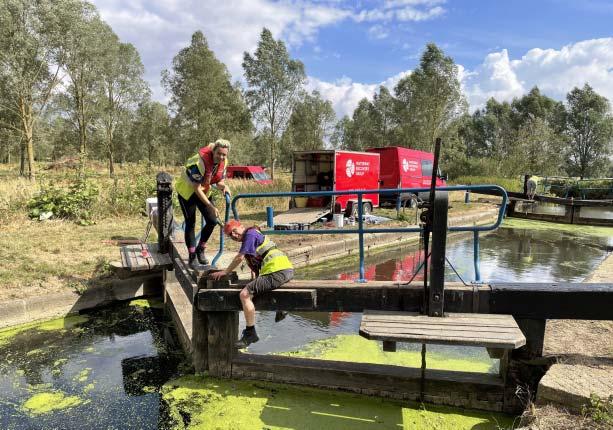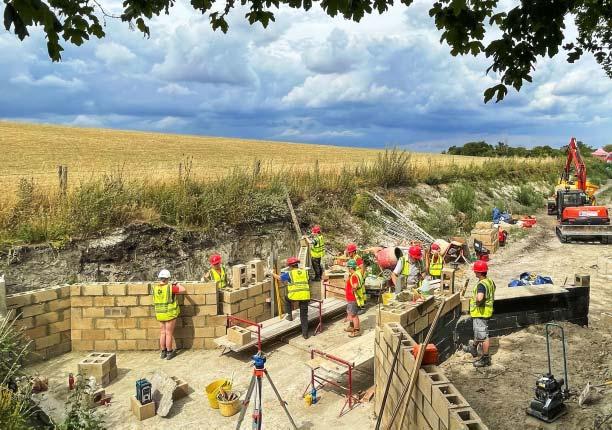




Yet another sign of getting back towards normal was the return of the WRG training weekend to give volunteers the skills they needed for the summer camps, this year hosted by the Wey & Arun, and once again masterminded by Ali ‘Womble’ Bottomley (above)
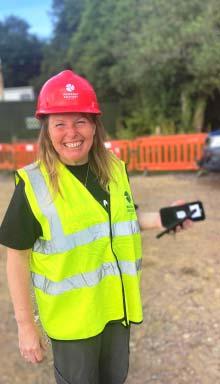
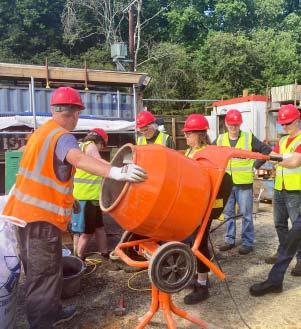
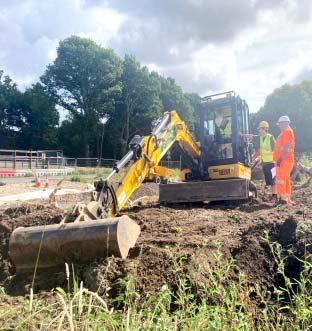
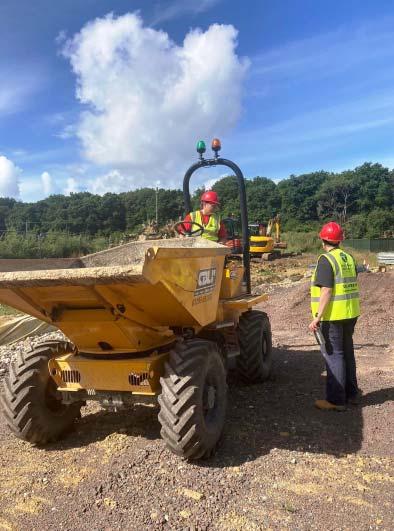
Editor: Martin Ludgate, 35 Silvester Road, East Dulwich London SE22 9PB 020-8693 3266 martin.ludgate@wrg.org.uk
Subscriptions: WRG, Island House, Moor Road, Chesham HP5 1WA
Printing and assembly: John Hawkins, 4 Links Way, Croxley Green WD3 3RQ 01923 448559 john.hawkins@wrg.org.uk
Navvies is published by Waterway Recovery Group, Island House, Moor Rd., Chesham HP5 1WA and is available to all interested in promoting the restoration and conservation of inland waterways by voluntary effort in Great Britain. Articles may be reproduced in allied magazines provided that the source is acknowledged. WRG may not agree with opinions expressed in this magazine, but encourages publication as a matter of interest. Nothing printed may be construed as policy or an official announcement unless so stated - otherwise WRG and IWA accept no liability for any matter in this magazine.
Waterway Recovery Group is part of The Inland Waterways Association, (registered office: Island House, Moor Road, Chesham HP5 1WA), a non-profit distributing company limited by guarantee, registered in England no 612245, and registered as a charity no 212342. VAT registration no 342 0715 89.
Directors of WRG: Rick Barnes, George Eycott, Emma Greenall, Helen Gardner, John Hawkins, Dave Hearnden, Nigel Lee, Mike Palmer, George Rogers, Jonathan Smith, Harry Watts.
ISSN: 0953-6655
© 2022 WRG
Chairman’s Page Mike says “Don’t ever think your contribution was insignificant” 4-5 Editor Camp reports and a pair of arms 6-7 Camp reports They’re back! Reporting from Chelmer, H&G and Wendover 8-25 Diary and bits & pieces 26-27 Progress reports from around the waterways system 28-33 John Baylis an appreciation 34-35 Waterways for Today new IWA report urges Government to fund the canals 36-37 London WRG on the Shrewsbury & Newport Canals 38-39
...are welcome, whether by email or post. Photos welcome: digital (as email attachments, or if you have a lot of large files please send them on CD / DVD or contact the editor first), or old-school slides / prints. Contributions by post to the editor Martin Ludgate, 35, Silvester Road, London SE22 9PB, or by email to martin.ludgate@wrg.org.uk.
Press date for issue 315: 10 September.
A year's subscription (6 issues) is a minimum of £3.00 (cheques to The Inland Waterways Association) to WRG, Island House, Moor Road, Chesham HP5 1WA. Please add a donation if you can.
Cover: Herefordshire & Gloucestershire Canal Camp: excavating the new channel for the canal at Malswick. See reports, pages 11-19 (picture by Ricey) Back cover (upper): Wendover Canal Camp: building the ‘narrows’ at Tringford. See reports, pages 20-25 (Colin Hobbs) (lower) Chelmer Camp: Painting Stonham’s Lock gates. See report, pages 8-10 (Dave Evans)
PLEASE NOTE: subs renewal cheques MUST be made out to The Inland Waterways Association NOTE new subs address below
I always hope that there will be lots of different news to include in my Chairman’s comment. However this time it feels like there is such a variety of news it’s going to be a strain to include it all and tie it all together into one coherent message.
The first thing to mention is that, after (for obvious reasons) a serious deficit of Canal Camp reports, this edition of Navvies contains five of them. I know that there are some who feel that Navvies is too frequently awash with camp reports – it’s not a sentiment I agree with and I am very pleased that we have some decent coverage of our return to ‘normality’. Although it has not been without incident we have worked hard to get Canal Camps up and running again and I think it’s important that the readers know that. Whilst Canal Camps are only part of the jigsaw that makes up the Waterway Restoration scene they are an important part. Amongst other things they have helped WRG and others carry the torch for volunteers on the waterways.
I talked about ‘incidents’ in the previous paragraph and we should not ignore the most significant one so far this summer: as you will read on page 11 our first Herefordshire & Gloucestershire Canal camp had to finish early due to some of volunteers catching Covid. Whilst this did cause some concerns I was reassured when chatting to one of the people who did catch it to hear them say “But it was Ok, you had a routine in place and a ‘Plan B’ and, when needed, you took the difficult decisions straightaway”. My thanks to all involved who treated what could have been a serious incident with appropriate seriousness and took those difficult decisions.
I also have to comment on the loss of two WRG stalwarts since the last edition of Navvies. Early in July both John Baylis and Dave Moore passed away.
The history of WRG and John Baylis are considerably intertwined. John was a found-
ing member of WRG and had been a director ever since the WRG Board was first formed. His passing is a huge loss to the waterways sector and of course we send our love and thoughts to his family.
I have many fond memories of working alongside John, my last encounter with him was a couple of years ago when we met up on the Montgomery canal to repair the memorial stone to WRG’s founder Graham Palmer on the lock which bears his name. As ever John was a pleasure to work with: his unique combination of good planning, attention to detail and pragmatism all served up with a solid core of dry humour made it a wonderful day in a wonderful place.
But to be honest to you, dear reader, I find myself not quite able to fully mourn his passing. To be clear, that is not due to any hard-heartedness on my part, just that I don’t quite feel he has gone. Put simply there are too many examples of his work all around the country for him to ever really disappear. Be it Frankton Locks on the Montgomery Canal, the Erewash at Langley Mill, Woolsthorpe Top Lock on the Grantham, the Cromford or many other locations around the system there are plenty of hard, physical monuments to John’s effort.
Of course none of those locks/weirs/ wharves/bridges were built wholly by John and I’m sure that John understood that the real strength of an organisation is that it brings together like-minded people and allows them to all make a contribution: whether you laid a thousand bricks in Frankton top lock or ‘just’ a hundred you played your part. And of course it’s not just the bricklayers – that wall required people to prepare the site, demolish the old wall, lay the foundations, barrow the bricks (and the mortar), lay the coping stones, brew the tea, etc.
Dave Moore too left a legacy on site –an understanding that the crucial ‘lubricant’ of all this work on site was the fun and enjoyment to be had whilst doing it. Yes people might have different motivations for coming
“Whether you have laid a thousand bricks or just one (or even just brewed the tea) – don’t ever think your contribution was insignificant”
...for the future to Jenny Morris who (as Mike Palmer mentioned last time) has left after a very long stint as our main WRG person at head office. All of us in WRG have different things to be thankful to Jenny for - in my par ticular case for helping out by repeatedly coming up with lots of useful stuff for Navvies at short notice, especially during the pandemic when it was a real struggle at times to produce a magazine full of interesting and worthwhile content. But it would be a struggle to find all the words for all of us to thank her for ever ything, so we went democratic and crowd-sourced them, and the result is this word cloud. By the time you read this Jenny will have received it in physical form!
along but ultimately the thing that kept them coming back was the atmosphere and the shared passion for what many might think is a rather strange pastime.
Of course Dave was also my father in law and I do miss him but his determination to see the fun and ridiculousness of every situation will stay with me.
And all of the above just relates to the work on site – every brick that is laid requires careful planning, paperwork and (what can seem like) endless meetings. Both John and Dave put in many, many hours on committees and their attitude was just as prevalent there – not only should that work be done well and effectively but there was enjoyment to be had.
So perhaps there are some common messages to end this Comment with:
. While WRG does have some people who seem to do a mountain of work, it only really works because there are so many of us

all making a contribution. Whether you have laid a thousand bricks or just one (or even just brewed the tea) – don’t ever think your contribution was insignificant.
. One of WRG’s true strengths is not just the people that comprise it, but the attitude and determination they bring along – don’t ever think your contribution was insignificant.
. In the last fifty years, thanks to contributions of money, time, effort and laughter, over 500 miles of waterway have been restored (and there are another 500miles to go). Don’t ever think your contribution was (or will be) insignificant.
The strength of a waterway organisation is like any waterway structure – it’s both the components that make up the structure and the precise way they are arranged. My thanks to you all.
Mike PalmerMartin receives the first big batch of canal camp reports since 2019, and compares important achievements on two arms of the Grand Union Canal...
This issue marks the return of a feature that has been largely missing from Navvies for much of the last two and a half years – the WRG Canal Camp report.
In 2020 the pandemic knocked out the entire summer programme of week-long camps (and much of the regional groups’ work too). In 2021 a short series of ‘trial camps’ tested our plans for working under new Covid-related procedures. But this year we finally returned with a full (if somewhat shorter than usual) summer programme. And the selection of reports in this issue show the results achieved by the first half of that programme.
My thanks to those who sent in the reports (and the pictures to go with them), who I reckon have done a good job of reporting back on a pretty successful programme of work in an interesting and entertaining way, as well as covering the less strictly work-related aspects of the week.
Those ‘less work-related’ matters included everything from an unusual evening entertainment star-gazing in an observatory with a local amateur astronomical group (See picture) to outings canoeing, paddleboarding and building home-made rockets – plus, less happily, in one case having to cope with a Covid outbreak on camp. No, we don’t just give you the good news in Navvies, we try to tell it ‘warts and all’.

But as you’ll see, it wasn’t entirely bad newsthe plans we’d made in anticipation of the possibility of this happening were followed, the team dealt with it and brought the camp to an orderly early close, and the subsequent camps on the same site (and elsewhere) were able to take place without any more such problems.
There are, as we go to press, several more camps either in progress or still to come. Please send your reports and photographs in so we can include them in the next issue. Thank you.
What do the Wendover Arm and the Buckingham Arm have in common? Well firstly and most obviously, they’re both arms of the Grand Union Canal, which (until they fell into disuse) used to link its main line to… surprise surprise… Wendover and Buckingham respectively. But secondly and very importantly as far as Navvies is concerned, they’ve both had some very good news as regards dealing with what have seemed at times to be intractable problems facing restoration plans.
Dealing first with the Wendover Arm, the Wendover Canal Trust’s team have been hard at work since 2005 on what’s known as the ‘Phase 2’ section, completely rebuilding the channel (the original canal would never hold water owing to the porous chalk soil it passes through) from Aston Clinton back to Tringford. There it will meet up with the ‘Phase 2’ section, already restored and navigable from the Grand Union Main Line at Bulbourne. But in between them is a short infilled section of canal, and this was proving rather a headache for BCS, as it turned out
that what had been thought to be harmless infill was in fact classed as toxic (it was 100year-old rubbish, with a lot of ashes and a little lead in it, I gather). And the cost of removing it to a specialist tip was not only beyond BCS’s means, but led to them having to withdraw a Lottery funding bid which had been provisionally approved. But now, Dacorum Borough Council and Tring Council have agreed to provide a total of £155,000 to remove 5,500 cubic metres of infill so that the restoration can proceed.
And secondly the Buckingham Arm. Its ‘intractable’ problem was a road crossing, In the 1970s during the establishment of Milton Keynes new town, a long section of the A5 trunk road was replaced by a new road on a new alignment which cut through the canal more-or-less at water level, just over a mile from its junction with the Grand Union Main Line at Cosgrove, with no obvious way of getting around it. And however much good progress Buckingham Canal Society made on the canal’s restoration at Cosgrove, at the Buckingham end, or at the various other sites they’ve worked on, there was always this “Yes, but what about the A5?” question hanging over it.

More recently BCS came out with a possible workaround – a major diversion away from the original route, dropping down by a couple of new locks to pass under the A5 using the northernmost span of the viaduct which carries the road over the Great Ouse river. At some point beyond the road crossing it would then climb through two more new locks to rejoin the original route beyond Deanshanger. That would be expensive - and beyond BCS’s means to fund in the foreseeable future? Perhaps. But then they went
becoming a
to National Highways (formerly Highways England, and before that the Highways Agency), who you may remember came up with £4m to reinstate the Cotswold Canals under the A38 roundabout near Whitminster, Gloucestershire, from a specific pot of money which had been set up to put right environmental damage that had been caused by new road schemes in the past. And although NH haven’t actually come up with the cash to create the concrete open culvert to carry the canal under the A5 just yet, they’ve taken the first big step towards it with internal approval and funding to proceed with the first stage of their feasibility study work. Fingers crossed that it will go all the way.
And the third thing that the Wendover and Buckingham have in common is (as some of you probably guessed I’d say!) that they’ve both been the scene of a great deal of volunteer work over the years – largely by their own dedicated teams but well supported by visitors: WRG Canal Camps, regional groups including London and BITM, and our friends in KESCRG.
And without that volunteer input they’d probably never have reached the point where outside funders would be convinced of the value of putting up the cash towards solving their ‘intractable’ problems.
See you on a worksite sometime!
Martin LudgateWorking on a navigable waterway (run by WRG’s parent body the Inland Waterways Association) makes a change. Evvo reports from the first week...
This was the first of two weeks of ‘digging’ to repair both walls of Stonham’s Weir to the east of Chelmsford. The walls have cracked and moved in places and the brick-eating thingamabobs had been feasting on lots of the soft original red bricks. Over the years many minor repairs had been conducted so we found lumps of concrete, some quite large, embedded all over the place and modern London stock bricks have also been found in all sorts of locations. So, firstly, we got stuck into the east wall and its return (see pic, below).
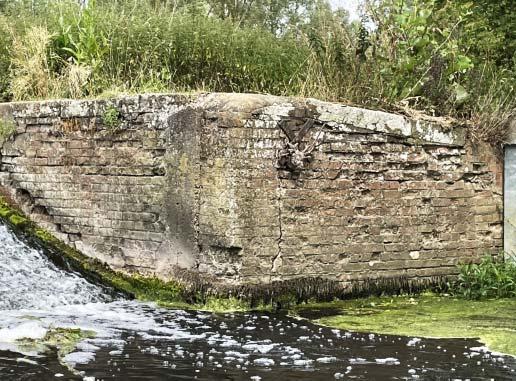
Stonham’s Lock (the ninth of thirteen
on the navigation, counting from the seaward end) and its adjacent weir are alongside a popular public footpath but otherwise in the middle of nowhere, so to speak. Access to site was from Boreham village along private farm tracks and then more than four hundred metres along the towpath. The two vans and the trailer were carefully positioned close to site after being turned round using forward and reverse gears many times amongst willow trees and willow tree stumps.
As the aerial photo (opposite) of the lock and weir from Google Maps shows, arriving at site was the easy bit! Getting the tools, gazebo (with roof this time), Burco, etc onto the ‘island’ took some care
and ingenuity.
Ian J cooked for us, excellently as always, and, during one breakfast, conversation turned to how leftovers should be used to avoid waste. (Etiquette demands that there be food left after a meal so the host / cook can be sure that everyone has had an ample sufficiency.) Potatoes and veg combined to make bubble and squeak for brekker was agreed to be a favourite of most around the table. However, should it be
hand-shaped into patties and fried or thrown whole into the frying pan and divvied up later? One of us (me) preferred the patties to be shaped into a flat-topped pyramid on which a soft-yoked poached egg could be placed with a ring of bacon around the base of the pyramid.
The idea of Michelin stars for canal camp cooks then entered the discussion, to which John ‘the Hawk’ Hawkins asked if there could be any negative Michelin ratings.
Length: 14 miles Locks: 13 Date closed: never - but it came close! (see below)
The Canal Camp project: Taking down and rebuilding deteriorated brickwork on the wing walls around the weir alongside Stonham’s Lock.
Why? Because if not kept in good repair the walls would eventually collapse, and the weir would no longer be able to fulfil its function of retaining the water at a suitable level for boats to navigate the waterway.


The wider picture: This is not a derelict waterway under restoration, it is a navigable waterway undergoing a long process of gradual improvement by its owners Essex Waterways Ltd (a subsidiary of WRG’s parent body The Inland Waterways Association) who took over to save it from closing down when the original company went bankrupt 15 years ago. It had been allowed to fall into a poor condition, and EWL has been working hard to put things right. But as a body with no regular public funding (unlike the Canal & River Trust and some other navigation authorities), EWL needs to rely on volunteer support otherwise it would struggle to keep the navigation open - let alone to improve it. Hence the use of Canal Camps to do the work.
I wonder what brought that thought to mind. Surely can’t be in relation to a canal camp culinary experience!
Anyway, moving on…. for a number of reasons there was a slow start to the camp but after three days we were moving at a reasonable speed and had the return wall nearly down to where we wanted it. This gave us a good idea of the extent of the ominous fissure between the corner ‘pillar’ (containing a lot of concrete with skinny scrap iron reinforcements) and the return wall (see pic below).
Eagle-eyed aficionados of wall restorations will have noticed that we have not taken down the whole wall. The walls have five ‘leaves’ (one ‘leaf’ is a half-brick of thickness) and we have chopped out the front three. We shall be rebuilding the two facing leaves as a one brick wall and filling the ‘missing’ middle leaf with concrete (appropriately reinforced and tied to front and back brick sections) for added strength.
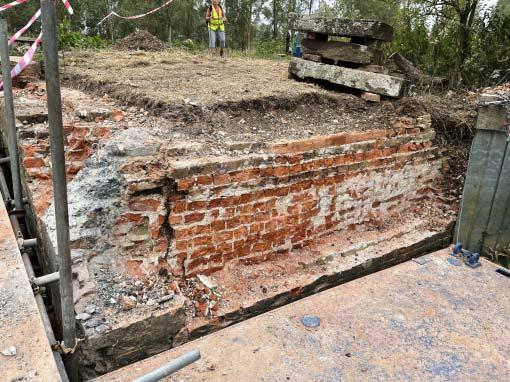
In this first week we also got stuck into painting Stonham’s Lock’s gates, which made a great difference to its appearance and to
the appearance of the painters! (see back cover photograph)
Week 1 had eight experienced WRGies and Alana W, our excellent DofEer (Duke of Edinburgh’s Award volunteer), who brought the average age of the camp from just under 70 to just under 65! She is doing a degree in marine biology and knows a lot about the contents of rivers, etc. Let’s just say that I won’t be swimming in such water; certainly not with my mouth open!
The team this week was made up of the aforementioned Alana, Ian J and John H, together with Sue and David C, Geoff M, John L and Paul H, who was my assistant leader. We were valuably assisted by Ant, Chris, Dan, Mac and Rob from EWL. My grateful thanks to them all (and Helen ‘the Purple Fairy’ who dropped in for a couple of days) for their patience, good humour and energy to find work when the intended work wasn’t possible or delayed.
I shall be assisting Paul H for the second week so he gets to write the glory report in the next Navvies!
Reporting from the first of three camps on the Herefordshire & Gloucestershire Canal, a week when not everything went quite to plan...
This is the tale of a Kescrg weekend and half-a-Summer Camp installing a culvert at Malswick on the H&G...
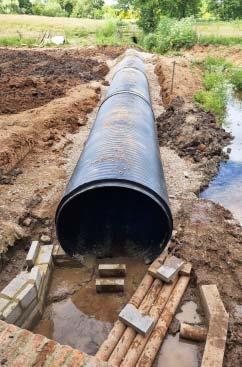
The Malswick project on the Herefordshire and Gloucestershire aims to create around ¾ of a mile of restored canal on or just parallel to the former line just south of Newent. The canal here was in-filled and used by the Ledbury and Gloucester railway in the 1880s until it in turn closed in the 1960s. [See also our Fact File on page 16]
The main thrust of the project is a huge earth shift to build an embankment across a
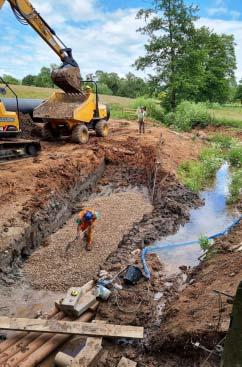
shallow valley and dig out and profile the channel along the length. However before the main profiling work could commence, two culverts had to be installed – one small one for a drainage ditch which the local team from the Herefordshire & Gloucestershire Canal Trust had already tackled, and one more substantial for a stream which has a light flow under normal circumstances, but rises very quickly to a torrent following rain in the area.
Three WRG Camps were scheduled for the site in July, with Kescrg taking charge of the first week and also running a technical weekend in June to build a relationship with the locals, prepare the site so the camps could hit the ground running, and try out the accommodation.
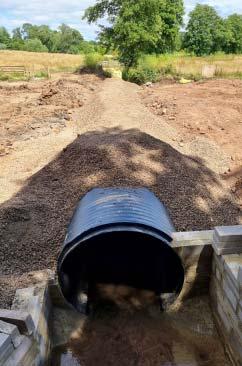
So, to the Kescrg June weekend – the least said about the Friday night probably the better, quite literally – karaoke in full bore at the pub meant conversation was nigh on impossible. Also the least said about the kitchen at the football club accommodation the better, as frankly there wasn’t one. But Eli produced wonders on an outside table and a twin gas ring in a veritable wind tunnel, and the need for a significant ‘plan’ for catering for the camps was underlined and inescapable!
However, to site – and the locals had already installed the concrete slab base for the head chamber of the culvert in the weeks leading up to the dig. The stream was diverted across the slab in pipes, and the culvert was to run alongside the existing stream bed, cutting off a gentle meander in a straight line. Adrian soon got to work digging out the trench for the first section of pipe under the guidance of Pete and the laser level, being vary careful to avoid the stream breaking in and flooding the works. The culvert itself was five 6m sections
of 1.8m diameter twin wall pipe, joined by rubber sleeves and giant jubilee clips / razorsharp finger traps. A couple of us spent some time fighting with these to get the pipe sections prepared while the first section of trench was being dug and levelled, and several dumpers were taking away the spoil and bringing in the shingle pipe bedding. Once the first section of pipe was in, Alan and Ricey could start building up the walls of the head chamber, with some precision block cutting required to fit around the culvert opening. Sunday followed much the same pattern, and by the end of the weekend four of the five pipe sections were in and it felt like we had a plan so we could hit the ground running on the first week of the Camps.
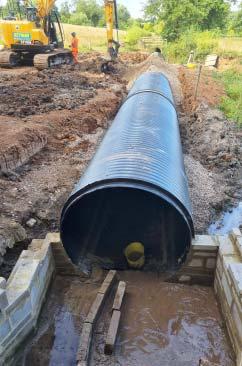
So, to July – a frustratingly late start on the Saturday of the camp due to a friendly match at the football club meaning we could not access the accommodation until early evening meant lots of hard work setting up the gazebos, catering tables and WRG
Cooker for the external kitchen and clearing as much space as we could in the club house for sleeping. Fortunately good weather was forecast and there was a covered outdoor area for meals – though everything needed cleaning to within an inch of its life. Finally we were all gathered for the safety talk, and could eventually retire to the pub, which was much quieter and inviting for the absence of karaoke.
On site, installing the last section of pipe meant breaking into the stream bed. In order to do this the stream was dammed off at both ends and 5 pumps were set going to drain the culvert and trench. Of course seeing as there were 5 pumps, at least 2 were playing up at any given time, but after a frustrating and somewhat damp and muddy morning, we had the culvert dry and
Adrian could begin digging out the final section of trench and the foundation for the tail wall.
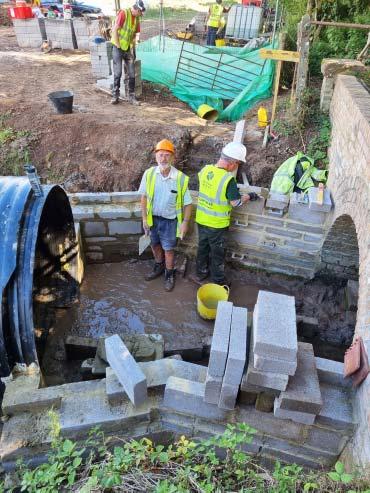
By the end of a long Sunday we had cast the tail-wall foundation, the final section of pipe was installed, and the stream diversion pipes had been removed and the lower levels of blockwork in the head chamber were complete, meaning the stream could flow through the new culvert. All of this was completed only just in time as the stream was nearly over-topping the dam by the time we allowed water back through site and trudged wearily home... to showers and a magnificent Eli-dinner, so no complaints there!
By the end of Monday it was critical that the blockwork in both the head chamber and the tail wall were well above normal water-level so the culvert could take the full flow of the stream and we wouldn’t have to dam the stream off again for the rest of the camp. This entailed another long day on site with much mortar mixing, block cutting and block laying, while Adrian and his dumper team continued to surround the pipe with shingle, and made a start digging out the old stream channel so it could be in-filled and compacted. Again the weather was kind and the dam was still just holding its own by the time we were finished and let the water through.
On Tuesday the plan was to consolidate the old stream bed, continue with blockwork and make a start on the main muck-shift, digging out the channel at the other end of site and bringing the spoil
down to the culvert area to build up the embankment.
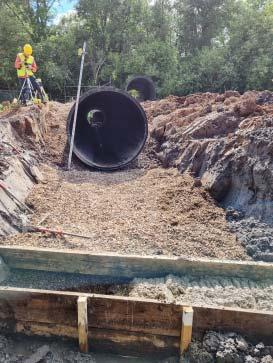
However one of the team had started to feel unwell by this point, and headed home. As a precaution the whole camp undertook Covid Lateral Flow Tests in the evening, and nearly half the camp returned positive tests. This came as a massive shock to us all, as we had all taken an LFT before travelling to camp, and had been careful with hygiene and personal space, to the extent that the accommodation allowed, and had spent almost all the time outside both on site and at the accommodation.
All the affected volunteers headed home that evening while those remaining headed to Over for a socially distanced walk around the basin and length of canal we restored 20 and 10 years ago respectively.
It was decided that on the Wednesday we would spend half a day on site ensuring everything was safe and and tidy with the kit mothballed in case the WRG Board decided to cancel the following weeks. In the afternoon we undertook a deep clean of the accommodation and similarly packed up all the accommodation kit so it could be whisked away if weeks 2 and 3 didn’t happen, then we headed home for half a week of unexpected free time and daily Lateral Flow Tests.
This was a really difficult and disappointing way to end the camp. But in three and a half days we had achieved a huge amount, getting the culvert in and fully commissioned and the site to the point where the following weeks could completely focus on the much shift and above-water block laying. Fortunately both these weeks were able to run and we had collectively made a huge impact on the project by the end of week three.
Massive thanks to the locals for their support, Ed for leading, Adrian and Pete for their operator & engineering skills, Dave for all his pumps and other kit, everyone for their great work and attitude, but most of all to Eli for supplying amazing sustenance-inadversity.
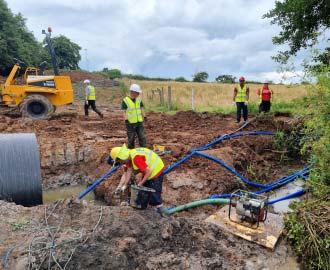
Hopefully Kescrg will be back at Malswick next year... it feels like we owe them a day or two.
All hands to the pumps!
Stephen Davis
Back for another (fingers crossed) less traumatic camp on the Herefordshire & Gloucestershire Canal at Malswick. The week 3 team kept a diary...
It’s Saturday and it’s my first day as an assistantleader and I’m really excited for the week ahead! Iarrived yesterday to get the lay of the land beforeour fabulous volunteers arrived. The day startedwith a slap-up brekkie cooked by last week’s leader‘(X)TC’ and dumper training with Adrian, while thisweek’s leader Ricey headed off to buy anothergazebo, and some early arrivals had digger trainingwith Paul who kindly stayed on from last week.Later we had the logistics of picking up from trainstations, introductions, ice breakers and Ricey givinga (longer than expected) health and safety talk.
A bit of forward planning with a wonkilydrawn table on the camp kit whiteboard so thatevery knew where they should be and when has made a world of difference

Now for a hopefully chilled evening getting to know the team before we start digging tomorrow!Bye for now,
My reflections for the first day of camp.
It’s been very warm for the volunteers today butwhen they returned to get showered and ready fortea they all seemed happy, some were just happyto be back on a dig after the Covid restrictions, acouple had instruction and training on dumpers,lots of clay was shifted and some were in awe thatAdrian ‘un-velcroed’ himself from his air-condi-tioned excavator cab to help direct dumpers full ofclay – very selfless of him to get out of the air coninto this 30 plus degree weather.
However, no-one offered to make me a brew thismorning whilst I cooked them breakfast. We allgot up an hour earlier to avoid the heat too.
Gutted! I hope they remember tomorrow.
Lou
Adrian directs the dumpers
PS The sound of karaoke coming from the local pub is quite a thing.
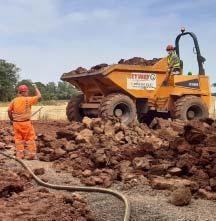
It is really hot today. Thankfully the wonderful Lou(who has now been offered copious amounts of‘brews’ whilst in the kitchen) had brought us lots ofice poles, frozen grapes and frozen melon slices to site.I’ve been working in the excavator for a couple ofdays now and had a bit of a revelation, what if wechanged the one-way system around at the dumperloading end of site to reduce the number ofmanoeuvres needed and maximise productivity? Well,I put it forward to the team and they loved it, not onlydoes faster loading mean more time driving dumpersand therefore more of a breeze running through that bitof space between their hard hats, glasses and dustmasks, but it means that we made lots of progress today.We had an evening trip to Over Basin which islooking picturesque, and it was great to learn aboutthe work WRG have done there over the last 20 or soyears as well as the local group keeping it in great shape. I can’t wait to come back to Malswick in a few years tosee how it progresses. Our evening almost abruptly ended during a ‘beer run’ to Tesco when Bob the van decided that one of its slidingback doors wouldn’t close and lock. Thanks Bob the builder was on hand to fiddle about with it before our rescueparty of Jonathon and Tony were really needed.Bye for now,
Dan
Length: 34 miles
Locks: 23
The Canal Camp project: Creating a new length of canal channel at Malswick including a large culvert to carry a stream under the canal
Why? Because the original channel was buried under an embankment carrying a (now disused) railway which replaced the canal after it closed. So it’s easier to divert the canal via a new channel built alongside the old railway
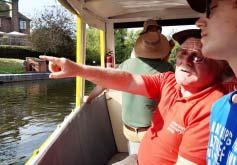
The wider picture: Since the Herefordshire & Gloucestershire Canal Trust was formed it has worked on many sites along the route including Over, Oxenhall, Aylestone, Kymin East and Monkhide. But as the restoration progresses, it hopes to start linking up these projects into longer restored lengths. So working between existing sites near Newent and Over makes sense.
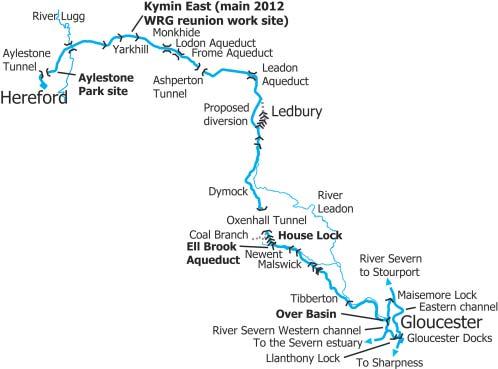
“I dug that bit!” - at Over Basin
Well Tuesday has been eventful. We arrivedon site to find that our dumpers had beenreplaced by wheelbarrows! That darn man-agement changing working practices, I knewthey had heard our secret Union meeting lastnight where we were discussing strike actionif we didn’t receive a 100% pay rise andnumerous more pub trips to keep us workershappy.
The dumpers returned soon after and Idecided to keep team morale high by namingthem after Thunderbirds characters, we areafter all creating our very own Tracy Island ofclay. Meet Virgil, Parker and Lady Penelope.I think we have managed to talk around‘management’ to our way of thinking as the evening ended up with a chauffeured tripinto town to visit some fabulous local establishments for refreshments.

F.A.B.
It’s Wednesday and theweather has finally changed,it’s still warm, but the sunhas disappeared behind theclouds which is giving us all some welcome relief David Smith came to joinus on site and help withtraining some of the teammembers so we can have a bit of a change and new experiences. David has given both me and Martinsome time in the excavator digging out clay and fillingthe dumpers with gravel.We’re a bit slower than Dan but then I got to do some block work! There was a bit left to complete after week 2 and I managed to gain an apprentice in theprocess, our DofE volunteer Thomas. He did really well and picked up some trowel skills quickly.We then got a few more of the team down to help place two very long and heavy lintels over aninspection chamber ready for the local group to finish off.Radio 4 were on site today interviewing us all about why we volunteer with WRG and why we keepcoming back, it’s because we all love it (but the offer of extra dessert this evening for saying somethingnice didn’t do any harm). We’ve been told we should be on the You and Yours show next week.[Editor may wish to note here we were on Monday 25th July 2022 “App Happy, Car Subscriptions andHydrogen Boilers” just over 26 minutes in.]It’s the Women’s Euro Quarter Finals tonight and our lionesses are playing. We also have what I canonly assume will be an ‘interesting’ half-time pub quiz created by our very own quiz master Sandra.Write soon, Bob
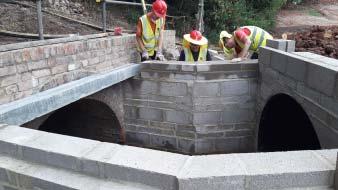
Today has been great, although getting upearly to help Ricey cook breakfast for every-one was a tough start to the day. Everyoneseems to like what we had cooked.
We had lots of laughs on site today,David is still around to help with the excava-tors and as Sandra would put it over theradios ‘titillating’ the gravel and clay.
After learning to use the roller earlier inthe week, Adrian gave me some training onthe excavator today and it was loads of fun,although lots to learn in a short space oftime. We also found that Bob was the expertin moving water across the site to tip overthe small culvert, he hardly spilled a drop!
Thursday 21
We had a replacement dumper delivered to site, so Dan had a new vehicle to getused to. Unfortunately, he played with his (door) knobs too much and one fell off.Laughs all round retelling that story to the rest of the team.

We all went into Newent tonight for Fish and Chips followed by a trip to a pub witha games room for skittles and pool. It was my first-time playing skittles, but I camesecond overall. Dan won and seemed to have a robotic arm with the speed they weretravelling down the alley.
Talk soon,
Thomas
Friday was another busy day on site, finishing com-pacting material over the small culvert and returningto the large culvert, tipping gravel around theblockwork at either end then adding clay to bring theground up to level. Shockingly, this required somegetting out of vehicles and using barrows and shovels!
As leader I often don’t get to do much practicalwork, but I was quite pleased with the small contri-bution I make to the blockwork earlier in the week.Anyway, today Bob chopped the block out to allow a power cable through in future. He did say I’ddone a pretty good job of it though.
Friday 22
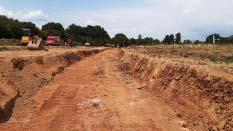
We left the site with the channel dug through in the higher part of the site and both culverts wellcovered with all the material we’d dug out. It’ll need a lot more clay to build the canal embankments,so our priority was providing access over both culverts to deliver this. After that we had lots of plantchecks and one last procession of moving it all to where the locals wanted it tomorrow – it’s a long site!
Then back to the accommodation to get as much clearing up done as we could to allow a swift getaway onSaturday, with Tony ably leading on the kit checks and trailer packing. Nobody seemed to believe I’d havethe kit ready to go to Wendover for 10.30am but we got there with loads of time, honest!Finally, after some ‘innovative’ cooking of leftovers by Jonathan, and an even more ‘innovative’frozen dessert left by Lou (we found that about 30s per portion in the microwave helped get a spoonthrough it), we went for some well-deser ved relaxation and rousing speeches in the local pubCheers,
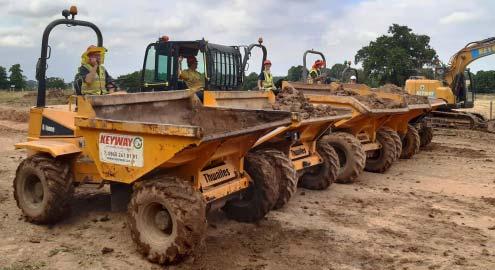
After two years off it was great to get out digging again. Having so many large toys toplay with was a fun challenge, particularly ensuring that the trainers and trainees werein the same place at the same time! The record-breaking heat on the first three dayswas a further challenge but we had a good think about how to handle that and themeasures we put in place worked out well.
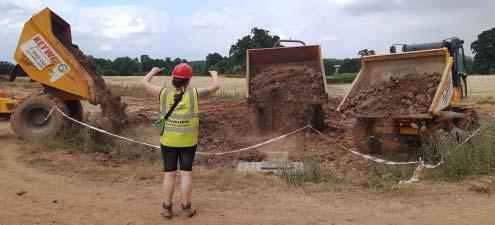
Many thanks to my ‘glorious’ assistant Sandra for her support before and duringthe camp, and to Lou for such interesting meals and keeping us cooled and hydrated onsite. My thanks also to Jonathan and Adrian for providing the benefit of their long expe-rience, to everyone who came along to provide extra help during the week, and to allour volunteers for working so well together.
See you next time,
Two weeks of camps completed some useful work building a stop plank ‘narrows’ - and produced two camp reports - one conventional, one less so...
Two weeks of WRG Canal Camps were spent working on the Wendover Arm. Rex Exon, who was on the second camp, sets the scene...
The Wendover Arm links the Grand Union Canal to Wendover, a small town in the Chilterns. Only two miles of the branch are navigable and then the remainder is at best in water but unnavigable to non-existent at worst.
This year’s project is at the end of the navigable section to build a narrows which will serve as a stop plank location for water
management, but also to prevent the passage of wider beam vessels, for which there is no further winding point to turn around before the final narrow lengths of the canal to Wendover.
The Wendover Canal Trust have built the concrete base for the narrows, and Week One constructed the block work sides. Not as simple as it sounds, but that’s a story for another day...
We’ll hear more from Rex shortly about the second camp, but now it’s over to Jess Leighton for a rather more unorthodox camp report in the form of a spreadsheet For Week one:
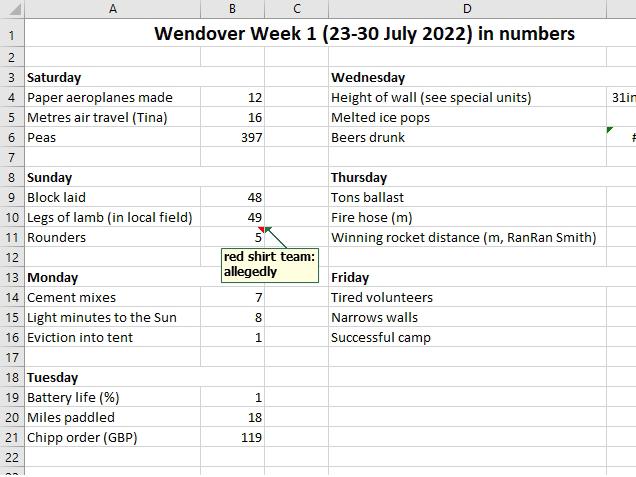
Above: By the third day, some impressive progress has been made on building the blockwork walls to form the sides of the narrows. Below: Evening entertainments during the camp included paddleboarding on the Grand Union Canal and (bottom) perhaps slightly more surprisingly, rocket-launching (see week 2 report for an explanation)
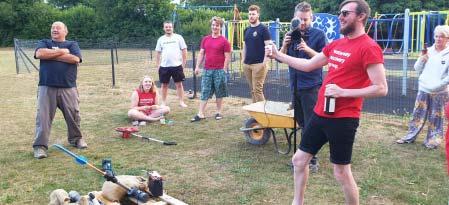
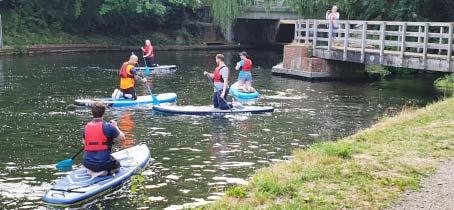


Completed blockwork walls at the end of the first camp, ready for brick-facing during week two
Length: 6 miles Locks: none (one stop-lock added) Date closed: 1904
The Canal Camp project: Creating a ‘nar rows’, a masonry lined length of canal channel, just beyond the current limit of navigation near Tringford.
Why? To to provide a place for insertion of stop-planks when the length beyond needs to be drained for maintenance work in the future, and to set the limit for wide beam boats which are unsuited to the far end of the Arm and for which there are no turning points beyond here.
Infilled section: contaminated infill to be removed
Aylesbury Arm
Tringford
Grand Union Main Line to Birmingham
The wider picture: This provides the link from the navigable length to the start of the two-mile ‘phase two’ section whose rebuilding is nearing completion, via an infilled length which is to be dealt with thanks to funding recently agreed (see Progress pages). This will bring boats to Aston Clinton in the not too distant future. From there to Wendover the Arm is in water and restoration will be much more straightforward.
Wendover
Halton
Phase 2 Little Tring to Aston Clinton: under restoration

Phase 3 Aston Clinton to Wendover: in water at reduced level, two new bridges needed
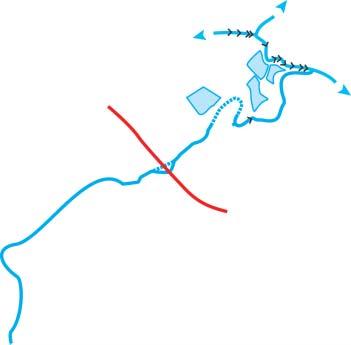
To London
Little Tring
Bulbourne to Little Tring: always navigable
Phase 1 at Little Tring: reopened 2005 including new bridge and winding hole
Canal Camp site: near Tringford
Back to Rex Exon for the second week’s report, once the Wendover Arm Trust had spent some time over the weekend backfilling, or as Rex puts it...
Our man Klondike Pete infilled the banks over the weekend with the help of a JCB. Week Two’s job was to construct the facing layer brick walls to the whole site and link it into the existing canal, bricklaying 19 double courses in front of the block work. Our accommodation was in the village of Flaunden. Flaunden is very nice, (a bit like Ambridge, but without the Grundys). Property prices around here start at £1million. The village hall is to die for, palatial by WRG standards. Even better there was some free beer for us courtesy of the Wendover Canal Trust, fresh from the Tring Brewery.
As always Sunday saw a slow start to the camp, with everyone getting to know the site and getting the first base course of brickwork laid. A lot of time was taken to ensure all the first sections were even, using a laser level on a theodolite base.
With a mixture of experience in bricklaying, today was really all about learning new skills and terminology. Traditional English bond, headers and stretchers. Squints, halves, knobs and queens to make the brickwork fit.
Two courses of bricks laid, plus setting up site materials and objectives. Tonight, we visited the Hertfordshire Amateur Stargazing Society. Half mile out of the village
into the rural countryside. Light cloud cover meant there was not much of the stars to see. However, we did get a good look at the moon. With only a relatively small telescope we were able to really see the moon with its craters and shadows. Fabulous. Also had a wide-ranging talk about the wider aspects of astronomy and the wonders of the cosmos.
We were laying a double layer of brickwork. Cheaper London Bricks to be used up at the back. The facing brick work to be made up of ‘heritage’ bricks made at the local brickworks. The heritage bricks certainly had better appearance and character; however they were a bit random in terms of flat bottoms curved edges and right-angled ends.
Three courses of brick laid today, along with some aching backs from working at such low levels.
This evening’s entertainment was Kayaking / paddleboarding and Canadian canoeing courtesy of the Hemel Hempstead canoe club. A good time was had by all with the kayakers winning the water netball, with Louise showing her competitive side. Colin took one for the team by falling into the canal several times. Whilst Anne Marie also went for a swim, this didn’t put her off and we can report she and Dave are the proud owners of two paddleboards of their own. Fish and chips to finish. A very good day.

Debates ongoing during the day about the issue of whether laying bricks ‘frogs up’ or ‘frogs down’ is the best. If the brick work is below, on or above the water line. A debate set to continue, I think...
Four courses of bricks completed today. Everybody was now getting into the swing of the work. There was less bending over, greater confidence in bricklaying skills and teamwork spirit.
Curry night. Lovely, thanks to our fabulous cook Anne Marie. Followed by plum crumble (using fresh plums from the dig site this morning) and a 1kg box of Guylian seashell chocolates purloined by Rex from the Milton Keynes foodbank.
An excursion to The Green Dragon was in order after dinner. A really nice pub with a
lovely pub garden. Colin chatted up the Flaunden Ladies Club, and possibly we persuaded the bar tender she should become a WRGie next year. A fine evening in the balmy evening heat.
Catastrophe. The Burco ran out of gas before heating up the water for morning tea break. Stress levels rose and the threat of wildcat strikes was mentioned. The day was saved by refilling the bottle at the farm shop 500 yards up the road.
Work was steaming ahead as no bending over was required and everyone’s confidence was built up. Also, Andy and the cement mixing crew were storming ahead with both mixers running non-stop.

Five courses of bricks completed today.
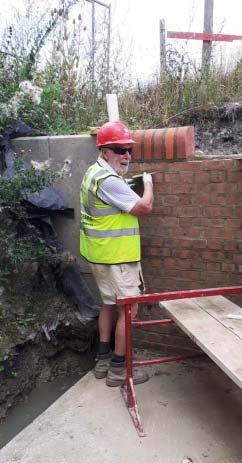
Johnathan (the new Alex) and Jenny (the new Jenny) paid us a visit bringing gifts. Red WRG tee shirts and cake!
All week all of the team have been building rockets to be fired on a compressed air contraption created by Colin during the lockdown. Tonight, all the rockets were fired with varying levels of success. Janice was the winner, achieving 119 metres with Tina, Andy and Louise close behind. Andrew’s rocket exploded on take-off, whilst Rexy’s rocket separated before reaching orbit.
On arrival at site, we went for a walk to see the length of canal going off to Wendover. The local society have for many years been making progress clearing landscaping and lining the canal route for two miles. It is anticipated that the whole length of the canal will be back in water in 5 years, and realistically navigable in 8 years.
Four courses to be laid today. Full steam ahead to finish the job. We were now
laying the brick work which will be seen by boaters and pedestrians for the next 100 years. (Most of the wall will be under water once the new sections are put into water.)
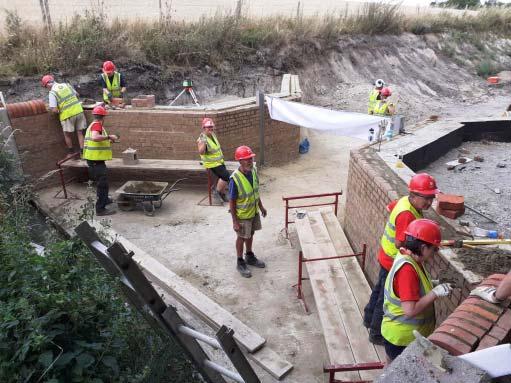
After lunch, the job was complete. We finished building he wall frontages and, just for good measure, we laid about 20 of the top-level facing bricks to show what the narrows will look like when they are completed.
This evening after dinner an awards ceremony was held with trophies and certificates being given. Awards including Willma for longest journey to camp (the Netherlands), Dorothy for the best camper van and Steve for eating the most bananas.
Thanks to: Anne Marie for her fabulous cooking. To Wendover Canal Trust for providing the project and the materials and to complete the job. The Tring Brewery and Flaunden for their fabulous village Hall.
Last but not least our thanks must go to Colin and Tina for the months of work, preparation and patience needed to put on a project like this.
Canal Camps cost £70 per week or as stated. Bookings for WRG Camps with Moor Road, Chesham HP5 1WA. Tel: 01494 783453, enquiries@wrg.org.uk. Diary
Sep 3-10 CC202213
Swansea Canal Camp: restoring lock chamber walls at Trebanos
Sep 10/11 KESCRG Surrey Hills Wood Fair: running ‘drive a digger’ fundraising with Wey
Sep 10-17 CC202214
Monmouthshire & Brecon Canal Camp: restoring lock chamber walls
Sep 17/18 WRG NorthWest Hollinwood Canal
Sep 17-24 CC202215
Oct 1/2 KESCRG
Swansea Canal Camp: rebuilding overflow weir at Ty-Coch Locks
Wey & Arun Canal: new liftbridge Birtley - with London WRG
Oct 1/2 London WRG Wey & Arun Canal: new liftbridge Birtley - with KESCRG
Oct 28-30 Family Camp
Wendover Arm: Family Canal Camp at Whitehouses Pocket Park
Nov 5-6? WRG Reunion? Date, venue and exact nature of event (and whether it happens at all)
Nov 5-6 London WRG Possible weekend working party if WRG Reunion doesn’t haappen
Dec 3-4 London WRG Christmas dig with KESCRG (to be arranged)
Dec 3-4 KESCRG Christmas dig with London WRG (to be arranged)
Dec 26-Jan 1 Christmas camp? To be confirmed, site to be announced - see page 37 and forthcoming
Canal Camps T-shirts made it into production a little later than usual this year, so if you didn’t get one on your camp you can get in touch with WRG Head Office enquries@wrg.org.uk to order one. Sadly the appropriate ‘opening up’ lock gates design below didn’t make it, it’s the usual diary list.
Letter received from a grateful member of the Herefordshire & Gloucestershire Canal Trust team:
This is a note to thank you for the efforts made by WRG and the teams in running the three weeks of camps.
At times it was a challenge, it being a site new to WRG but by co-operation all round the end result was very successful. It was unfortunate that Week 1 had to be curtailed just when the group were getting stuck in.
Let’s Dig Again
By the end of the three camps the whole large culvert was installed and surcharged, with a headwall at one end and a chamber at the other and that was a significant achievement. Much clay was dug out and channels formed which now give a ‘canal-ish’ look to the site – you can see what will go where.
The small culvert was also surcharged with material and this has left the site with the ability to travel the whole length on the route which means that we can prepare for the big push to build the embankments and start to get the cut in water.
So once again many thanks for all the efforts.
Philip Marshall
number e.g. 'Camp 202201' should go to WRG Canal Camps, Island House, contributions to Dave Wedd. Tel: 07816-175454, dave.wedd@wrgbitm.org.uk
01494-783453 enquiries@wrg.org.uk
& Arun Canal Trust Ed Walker 07887-568029 ed@edwalker.eclipse.co.uk at Trebanos01494-783453 enquiries@wrg.org.uk
Mike Chase 07974-395294 mechase1975@gmail.com 01494-783453 enquiries@wrg.org.uk
Ed Walker 07887-568029 ed@edwalker.eclipse.co.uk
Tim Lewis 07802-518094 london@wrg.org.uk 01494-783453 enquiries@wrg.org.uk to be confirmed - see page 3701494-783453 enquiries@wrg.org.uk
Tim Lewis 07802-518094 london@wrg.org.uk
Tim Lewis 07802-518094 london@wrg.org.uk
Ed Walker 07887-568029 ed@edwalker.eclipse.co.uk issues of Navvies 01494-783453 enquiries@wrg.org.uk
Diary dates You will note that the Diary above is extremely short. Basically the regional groups are still organising things on rather an ad-hoc basis, not helped by what seems to be a bit of a problem finding accommodation at the moment.
Do get in touch with the groups - they generally have easily-found Facebook groups which use the ‘events’ facility to give details of working parties - and we hope to get the diary back to something like its former self in the forthcoming issues.
Reunion and Christmas camp You may also have noticed that two of the events which did make it into the diary are looking rather provisional.
We do hope to be able to organise a Reunion / Bonfire Bash weekend but it is proving tricky to find suitable work AND accommodation for the number of people likely to attend.
We will continue to try to organise something - even if it means moving away from our usual early November date. And in the meantime if you are from a canal society and you think you may be able to host us, please get in touch.
And the same goes for the Christmas camp.
Free First Aid Training Places are available on a one-day course in emergency outdoor First Aid (i.e. exactly what canal restoration volunteers need) on three days in September - Sat 24, Sun 25 and Mon 26.
It’s being funded by WRG and is completely free to anyone involved in waterways volunteering whether with WRG, a local canal society or whatever.
The location is near Swindon, close to Junction 15 on the M4.
If you’re interested in taking part in one of these courses, please contact George ‘Bungle’ Eycott on bungle@wrg.org.uk and say which day(s) you’re available to do the course on.
Apologies for the lack of an ‘Infill’ jokes page and contribution from WRG’s agony aunt Deirdre in this issue, and more seriously, also for not running a restoration feature article this time - I’ll try to ensure both of these return in the next issue.
No apologies for the number of Canal Camp reports this time though - and hopefully we’ll have some more in the next issue too. So please get writing them now! And get them sent in. And don’t forget to send some photos to! Many thanks, The Editor
SUCS volunteers are into the final couple of hundred metres of channel lining to complete before the canal can be reopened to Crickheath Wharf
June working parties: Shropshire Union Canal Society (SUCS) volunteers continued the fortnightly programme of restoration in June on the Montgomery Canal, near Crickheath, where the channel is being re-lined to waterproof it.

A main task for this working party was to address the essential task of cutting 14 metre lengths of the lining ‘carpet’ from the massive rolls that had been delivered. Each piece is 6 metres wide and very heavy. These were rolled up and carried by a team of six bearers along the embankment to the positions of need.
Also another 20 metres of waterproof lining was put down in the channel and covered with building blocks to compress the blankets of material.
There are now 160 metres that have been completed leaving a further 170 metres to do, to complete this part of the restoration process to connect the basin at Crickheath to the current limit of navigation at Gronwen Bridge and so to the national waterways network.
60 metres of stone rip rap was also put down. This stone strip covers the top metre of a canal channel to break up the wash created by boat movements.
The head wall of a Culvert passing under the channel that has been under construction, was also completed using sandbags.

June’s second working party began on a blisteringly hot Friday, when volunteers from the design consultants Arcadis boosted the work force numbers. This laid the foundation for a surprisingly, prolific weekend session, which added another 40 metres of lined channel to that already completed. In the region of 4,000 blocks were used.
A length of channel is lined with a ‘sandwich’ of four layers of waterproofing materials. It is then ‘paved’ with building blocks to weight them down. These layers are put down as huge overlapping blankets which are 6 metres wide and stretch 14 metres from the towpath down and across the channel to the top of the offside bank.
The weekend’s effort reduced the length remaining to be done down to 160 metres. Once complete, all efforts can be directed toward surfacing the 330 metres of accompanying towpath. Machine based work continued with channel shaping next to Crickheath Basin.

July working parties: On another scorching Friday, 15 volunteers from telecommunications giant Openreach significantly boosted the work force numbers on a community volunteering day which laid the foundation for a prolific weekend of action. The group was divided into two teams, one of five volunteers and a larger one of ten with some regular volunteers to manage proceedings. The smaller group tackled a very dirty, muddy and particularly difficult length of six metres where a drainage sump had previously been located to link two lined and blocked sections of channel together. This involved barrowing a considerable amount of mud and silt up the side of the channel to the top. Then the channel was lined and blocked. The other group worked flat out on lining and blocking toward Crickheath, completing an amazing 26 metres in the day. The whole group really enjoyed the demanding, physical work which was much appreciated by the regular team.
This left just another 90 metres to do to complete the lining and blocking. A twenty metre trial section of the 330m of accompanying towpath was satisfactorily completed on the Sunday.
Machine-based work continued at Crickheath with very accurate, precise channel shaping being the focus. Finally, a small team spent the whole weekend cutting the massive rolls of lining material into 14 metre carpets for use next time. Not a very glamourous task but an essential one.
Another massive step forward was achieved on the second July working party with over 3,000 building blocks put down to weigh down the lining material. Some detailed work was done to bring the top of the blocks into line through a hefty session of angle grinding. The pressure is on to meet the end of October 2022 deadline for completion but each session is significantly reducing the massive task. The HLF funding that has financed the project will end in October, hence the need to complete all work by the end of that month.
The final few metres of untreated channel were shaped to the precise angle so the next work party will see a change of emphasis: lining and blocking will continue to cover this last 60 metre section and stone and soil rip rap will be added to a hundred meters of lining material between the top of the blocking and the towpath edge using power barrows to transport the material.
We have benefitted recently from new volunteers but we would really welcome more for the four work parties to be held in September and October. Interested people should see https:// shropshireunion.org.uk/work-party-schedule for details of dates and contact details.
Fred Barrett, Publicity OfficerTracking down the Water Leak: The sluice gate at Whitehouses was closed and the section of canal at Whitehouses was rewatered. Water was observed passing the closed sluice gate. There were minor leaks through the block wall on Bridge 4 side of Whitehouses. The block walls were sealed using a cement grout brushed onto the walls. Further observations showed that there is a seal on the back of the sluice gate requiring the gate to be accurately aligned in order to effect a seal. More trials will be undertaken.
Canal channel on the Little Tring side of Bridge 4: The canal banks which had been profiled earlier in the year were trimmed for a distance of 40m in order to lay the next section of Bentomat waterproof bentonite matting. Bentomat was placed on both banks using the ‘Bentomatic’ (excavator with special attachment) and the lower edge protected with timber boards.
During the remainder of the work party the hollow block foundation was placed, solid blocks and coir rolls were installed and
backfilling to the banks was commenced.

The former rubbish tip infilled area: Trial holes were excavated in the tip area near the fence to determine the position of the coal tar lining. It was found that the fence had been erected in the wrong position. It was concluded that Wendover Canal Trust would remove the fence, erect a temporary fence to allow ash removal from the tip and then erect a permanent fence on the new boundary line.
Tidy Friday was spent strimming and cutting the grass on the path, around the benches and at Whitehouses. The area looks much more inviting.
Construction of the ‘narrows’: Materials were moved from the store at the carpark along to the working area at the site for the new stop plank narrows ready for the Waterway Recovery Group canal camps, due to start on 23rd July for two weeks. To see how they got on, and also for more information including a map showing where the worksites are and how they fit together, see the camp reports on pages 20 to 25.
Mikk BradleyMeanwhile on the Lichfield Canal, they’re busy concreting the canal bed and rebuilding old Lock 24 (to be replaced with a new lock) as a feature
Lichfield & Hatherton Canals Restoration Trust work parties have concentrated their efforts on the Tamworth Road section of canal south east of Lichfield city centre. In Pound 25 work has re-started on laying concrete on the canal bed and about another 30 feet has been finished. An hour after the last 12 feet of concrete was laid it poured with rain and the new concrete slab was soon three inches under water as the ‘big pipe’ (the storm drain that was laid in the canal bed after the canal closed, and which is being progressively removed as restoration takes place) had flooded. Since concrete sets under water, the slab was inspected the next morning and all was well.
The team are currently using cement, aggregate, DPC membrane and reinforcement at the rate of over £1,200 per month on this section alone. Rain over this period has been the main problem and at times the site around old Lock 24 (which is being replaced by a new lock on a different site to facilitate getting the restored canal under Cricket Lane – the old chamber is being modified and retained as a feature) was a complete quagmire.
The piers and railing along the right-hand side of old Lock 24 have been completed, and the right-hand wall has been extended up to the inspection chamber. The wall has been topped off with blue bricks, and the bank above graded and planting has started. The blue brick wall alongside the neighbouring garden has been rebuilt and pointed and is once more in good condition. The left-hand wall has been progressed and is moving forward with concrete behind, and the loose block wall above the towpath line has been extended.
Work has started to relocate the canal towpath above old lock 24 onto the southern boundary and also to reduce its height. This will then, in turn, allow the next few metres of south canal wall to be constructed


Lapal Canal Trust’s work to create a wharf and winding hole to enable boats to enter the restored canal at Selly Oak is nearing completion

Lapal Canal Trust are working on the restoration of the disused 5.5 miles of the Dudley No.2 Canal between the current limit of navigation at Hawne Basin, Halesowen and the junction with the Worcester and Birmingham Canal in Selly Oak.
The Dudley No2 Canal was completed in 1798 to provide a more direct route via the south of Birmingham from the coalfields of the Black Country to London. It included the 2.2 mile Lapal Tunnel and a 60ft high embankment through Leasowes Park. The tunnel suffered a collapse in 1917 that was
not repaired, but the remaining sections remained in use until the mid 1950s. More details can be found on our website Lapal.org and our Facebook page.
The connection to the W&B was lost to a retail park, but the re-instatement of the link has commenced with the Whitehouse’s Wharf construction which is nearing completion. Whitehouse’s Wharf was an original feature of the site and provided the winding hole (turning point) for the canal but was located to the left of the lime kilns shown on the drawing. The construction of a new Whitehouse’s Wharf is necessary to provide the winding hole to access the new section of canal around the retail park – because the
junction is too tight for boats to turn into the Lapal Canal from the Worcester direction, so they will need to carry on to the winding hole, turn and come back to the junction. This is shown at the bottom right of the sketch.
Andy Street, the Mayor of the West Midlands, broke ground for us on the construction of this 16 weeks ago. Since then the topsoil was removed revealing the piling which had installed previously. The height of the piling was adjusted to suit the capping. Concrete backing and anchor rods were installed then the capping beam constructed and oak fenders fitted.
There have been challenges along the way with equipment breakdowns and cofferdam leaks but we have made better progress recently with our contractor, Land & Water Services, working the weekend to catch up. We have now removed 75% of the soil and puddle clay is going in. The autonomous puddling machine providing

some entertainment for passers-by (see picture). The lowering of the brick wall that can be seen in the left of the photo will allow for a consistent depth to be achieved across the entrance to the wharf.

Over the next two weeks the remaining soil should be gone and the remaining construction of the final capping beam section and surrounding paths will commence. Hopefully by the next issue we can report on the completion of works.
Justin MalpassLooking back on the life of John Baylis, longtime WRG Director, festival tractor driver, a ‘Mr East Midlands Canals’ and much, much more...
“How and when did you first get involved in canal restoration?” Helen Gardner of WRG asked John Baylis, as the standard first question of one of her excellent ’40 views for 40 years’ series of interviews in Navvies to mark WRG’s 40th anniversary in 2010.
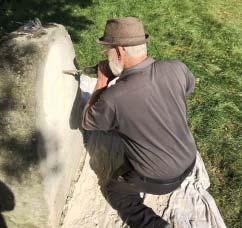
Well, when I say “first question”, in this case I actually mean “only question”, because John’s response, detailing his early involvement and all that it led to, went on for so long that it not only used up all the available time (and space in Navvies) but answered everything that Helen wanted to know. That’s not to say that John was an incessant talker; on the contrary it’s a measure of the sheer breadth of his involvement in waterway restoration.
To provide a simple answer to the question, his actual involvement began when he joined what is now WRG’s parent body the Inland Waterways Association in 1969; he went to the nearby social meetings of its Sheffield branch which was struggling a bit at the time, and together with fellow new member Mike Briggs and others he helped to get the branch going again, gain new committee members, and start supporting nearby and not-so-nearby restoration projects (this was in the days before WRG existed, but there were growing numbers of ‘mobile navvies’ who worked on whatever restoration had work for them). These included the Ashton and Lower Peak Forest (this was the height of the campaign to reopen the Cheshire Ring) and ‘the one that got away’ – the ill-fated Derwent Navigation (where restoration ultimately came to a halt following legal battles between waterways supporters and other interests). Travelling further afield they supported the Kennet & Avon in Bath, the Warwickshire Avon where the legendary David Hutchings was leading the push to open the Upper Avon from Evesham to Stratford.
Reorganisation of IWA led to the creation of its East Midlands region, with Mike and John involved, and to contact via IWA’s
national Council with London-based Graham Palmer who founded WRG in 1970. This in turn led to the creation of regional group WRG East Midlands based on the Erewash at Langley Mill, and to John’s involvement in WRG for the rest of his life. It also led to his association with pretty much every restoration project in the East Midlands over the following years.
These included the early stirrings on the Chesterfield Canal, where the successful 1960s campaign by Retford & Worksop Boat Club to keep the Trent to Worksop length open had led to the founding of the Chesterfield Canal Society (now Chesterfield Canal Trust) – a proposal to simply reopen the first derelict lock (Morse Lock above Worksop) to enable boats to reach a winding hole (turning point) beyond was met with a blank refusal by British Waterways. This led to a campaign, and ultimately over 25 years later to reopening all the way through to Norwood Tunnel, an achievement which was “completely out of the question” back then –“Even as far as Shireoaks was unimaginable”.
Deciding to “let them get on with it”, John shifted his attention to the Montgomery Canal at Frankton at Graham Palmer’s request, and got the Erewash team (including
champion brickie ‘Mick the Brick’ – Mick Golds) involved. The restoration was very much a joint effort with the Trent & Mersey Canal Society and WRG North West involved too, and one of two interesting episodes including BW’s grouting contractor quietly lending them a grouting machine to ‘get on with it’ (not to mention John managing to get a speeding ticket while driving the scaffolding lorry!) but was completed to tight timescales. John moved on to lead the early work at Aston Locks including the tricky job of lowering the top of Lock 1 by a foot (the section from there to the new Graham Palmer Lock was being lowered, to counter subsidence) before handing over to Mike Palmer. Meanwhile there were the ‘Stratford Blitzes’ – a series of winter work programmes aimed at helping the cash-strapped National Trust team keep the restored southern Stratford Canal navigable in the 1970s and early 1980s before BW finally took it on. It wasn’t all practical work, though: John was also involved in producing the first WRG safety booklet (the direct ancestor of today’s WRG Volunteers’ health & safety guide issued to Canal Camps volunteers) and having been on the unofficial WRG Committee (or as he put it “largely Graham’s cronies”) John was one of the original Board members when WRG became a limited company and IWA subsidiary in the early 1980s, submitted the bid for funding which helped us to buy the first fleet of four vans / minibuses for the expanded Canal Camps programme in the late 1980s, and served on the Board for the rest of his life.
Latterly much of John’s involvement
was centred around the East Midlands – this included the gradual extension north from the initial small basin at Langley Mill which had already been opened (before John’s time) to create a terminus for the restoration of the top end of the Erewash Canal and Langley Bridge Lock. Technically part of the Cromford Canal, this developed from barely 20 yards to the boating centre that it is today, with dry dock, quarter mile or so of basin, and a basis for the start of the Friends of the Cromford’s current plan to reopen the next section under the main road crossing and northwards. Then there was his involvement in the early work further up the Cromford at Ironville (and later as a founder officer of the new Friends of the Cromford group), the top lock at Woosthorpe on the Grantham, and more. And we mustn’t forget the prolific output of the Erewash Canal Preservation & Development Association’s Langley Mill workshop, from specially designed paddle anti-vandal locks for the Erewash to grappling hooks for the BCN Cleanups, not to mention “stuff for festivals” –stillages for storing timber for the chippies at the IWA National, and racks for the ‘Tardis’ (storage trailer used by the Festivals team).
And on the subject of Festivals, John could often be seen on the site services crew – earning his nickname ‘Bogs’ with the team plumbing-in the toilets, driving a pickup truck on the dustbin emptying round, or latterly driving the tractor. This started at 2002 at Huddersfield, where he remarked that “I used to answer the radio as ‘Tractor One’ –[camp leader] Mick Beattie made the comment that I always made it sound as if I was the first of several” – and this gave him another nickname…
And we haven’t even mentioned his chairmanship of IWA East Midlands, and also of IWA’s Navigation, Technical and Amenity Committee – nor his extensive boating around the system with his wife Christine on their succession of three narrowboats.
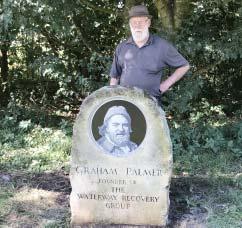
Modestly summing up his four decades volunteering for the waterways and in particular the regular Friday Erewash work parties, he said “I’ve always enjoyed mechanical work – it keeps you out of mischief and it’s somewhere to go on a Friday”.
Thank you John for your so much greater contribution to the waterways.
Martin Ludgate (with much material from Helen Gardner’s interview with John)
So why are we restoring canals? Come to that, why are we even maintaining the canals we’ve already got?
Those probably aren’t the sort of questions that you’d expect Navvies to be asking its readers, or even to feel the need to provide answers to. And indeed, we’re not. We know that there are lots of good reasons folks get involved in supporting the waterways – anything from the heritage interest of our unique canal system or the wish to enlarge it to create more routes to enjoy by boat, to the canals’ nature conservation value or simply the enjoyment of being part of the volunteer restoration community.
But in this case it’s WRG’s parent body the Inland Waterways Association that’s answering the question – and doing it from the point of view not of the waterways restoration community, but of the Government.
Why? Well, it won’t have escaped your notice that recently the country’s been facing a fairly tricky time economically. Not only has there been the impact of the pandemic over the last two and a half years, but more recently the sudden rise in inflation has been causing some serious problems. And this has come at a particularly bad time for the Canal & River Trust, which is responsible for the majority of our navigable canals and rivers, as well as a number of the disused ones that we’re working on restoring – such as the Grantham, Montgomery and Wendover.
CRT was set up as a national charity in 2012, under a move from the previous public sector organisation British Waterways. Like BW, it received an annual grant of public funding, but unlike BW it didn’t have to negotiate with the Government for money every year, it was given a 15-year contract with a guaranteed amount each year. This started at about £40m, rose to £50m, was index-linked to inflation for several years, but then lost its index-linking for the final five years. And as I’m sure you’ve spotted, that loss of inflation-proofing kicks in right now, just as inflation’s really taking off. Oh, and there’s no guarantee whatsoever of any further
public cash once the 15 years are up in 2027. With this income representing very roughly one third of all the money that passes through CRT (with broadly similar amounts from boat licence / mooring type income and from commercial business income such as rental on its property investments), losing the whole lot in five years’ time would be likely to be pretty disastrous. Even losing the amount represented by a 10 percent inflation rate is fairly bad. And yes, I know there are many out there (and often they have a point) who say that the waterways authorities could spend what money they have a whole lot more carefully and with a better set of priorities, but you’d be stretching things to make up for the sort of loss of funding we might be facing. And that’s just to keep the existing canal system going, never mind adding any more restored canals.
But it’s not all bad news. You’ll have read elsewhere in this issue of positive decisions in favour of giving public money to canal restoration. And there have been further pots of public money arriving under the guise of post-Brexit and Covid recovery programmes. Yes, they have cringeworthy names like ‘Levelling up’ and ‘Shared prosperity’, but at the end of the day they’re pots of money, and frankly if I were a canal society fundraiser seeking cash for a road crossing I’d bid to the Boris Johnson for Pope fund if I thought it would get the bloody thing built… Hence IWA’s report Waterways for Today. It aims to demonstrate the benefits of waterways to the Government, local authorities, planners, ‘green’ groups, and those (like the National Lottery) in charge of funds. In particular it shows that the canal system is not only worth supporting on a one-off basis when a bid is received for a restoration project, but at a higher level – that it is a sufficiently vital, unique and irreplaceable part of Britain’s infrastructure that it simply must be given adequate financial support to maintain the existing system. Not only that, but to continue bringing the 500 miles of restorable but disused waterway back into use. It does this by going through 12 different benefits – the list opposite is reproduced
from IWA’s magazine Waterways. You’ll see plenty that might not feature on your list of why restoring the canals is a good idea. But you’re not the Government, which is being asked to commit to continued funding of some tens of millions a year – and is unlikely to be convinced by “it’s so people can continue boating, because the canals were built for boats” type arguments. It aims to show all the wider benefits of the waterways, many of
which fit very closely with Government objectives – whether it’s wellbeing, green infrastructure, climate change resilience or all manner of other buzz-phrases that you’re probably already sick of. It might just make the case for funding the existing system – and the waterways under restoration too. And it’s been launched by IWA – it should be on waterways.org.uk by the time you read this.
Martin LudgateThe IWA Waterways for Today report pulls together evidence from a wide range of sources that demonstrate the value of the waterways, by identifying 12 key benefits with some compelling quotes, case studies, stats and data about each one.
. Benefit 1: Contributing to the country’s economic recovery – waterway regeneration projects can level up rural and urban areas and improve the lives of millions of people
. Benefit 2: Increased spend in local communities – boat-based tourism and leisure activities contribute £2.5 billion to the economy each year, with people on day trips, boat holidays and taking part in water-based activities spending even more in local pubs, cafés and shops
. Benefit 3: Savings to the NHS and social care budgets – waterways are well-placed to improve the health, wellbeing and longevity of the many people living near them, through increased physical activities and social prescribing
Natural and built environment
. Benefit 4: Protecting and improving the natural environment – waterways are bluegreen corridors that allow opportunities for reconnecting disparate habitats, biodiversity net gain and improvements for wildlife
. Benefit 5: Waterways heritage for future generations – with their historic buildings and structures, waterways form a vast open-air heritage network, accessible to everyone and bringing history to life for current and future generations
. Benefit 6: Sustainability – planning for resilience and climate change: our waterways face unprecedented challenges from climate change, but they can be part of the solution through adaptation, mitigation and enhancing the natural environment
. Benefit 7: Connecting communities – access to the paths that run alongside our waterways is free. These inclusive, flat, linear routes can be used as active travel corridors to connect communities and provide passage between urban and rural areas
. Benefit 8: Education and young people – waterways offer opportunities for hands-on learning in science, technology, engineering and maths subjects, as well as the humanities and arts, through outdoor classrooms, visits to local waterways and inter-generational learning
. Benefit 9: Jobs, training and apprenticeships – waterways offer many opportunities for employment, training and apprenticeships including in the tourism, leisure, hospitality, engineering and construction sectors
. Benefit 10: Improved physical health – waterways open up multiple opportunities for outdoor activities such as walking, running, cycling, fishing, sailing, canoeing, paddleboarding and volunteering
. Benefit 11: Improved mental health and wellbeing – waterways can boost wellbeing and improve mental health through physical recreation shared social experiences and connecting with nature
. Benefit 12: Creating better places to live – waterside locations create a sense of place that can enhance people’s enjoyment of the area they live in. This can encourage greater diversity and inclusivity across local communities
It’s not just about week-long Canal Camps. London WRG have been out again, this time on a weekend working party on the Shrewsbury & Newport

London WRG on the Shrewsbury and Newport Canals 23-24 July
London WRG enjoyed a great turn-out on our first time back in Shrewsbury since the pandemic. We had so many people some of them had to camp in the paddock next to the accommodation in Uffington village.
The weekend’s aim was to prepare for the week’s Canal Camp led by Mick Lilliman at the north west portal of Berwick Tunnel the following month. Our main task was to demolish the crumbling lengthsman’s hut (built into one side of the portal) in an orderly fashion ready for it to be reconstructed by the camp. The team took this apart very speedily with the help of a small digger although they did moan a lot about having
to wrap the stones in carpet protector to keep the elements off them.
We built the base for a section of boardwalk which will protect tree roots from pedestrian traffic and forms part of the wheelchair accessible path being created on the non-towpath side of the canal. We installed a section of permanent fencing across the top of the portal face. We took advantage of having three Tirfor winches on site to get up a lot of tree stumps. We also took the work boat out on its maiden voyage and, more importantly, also brought it in again.
It felt very much like a return to our old pre-pandemic form and we steamrolled all available jobs thanks to the number of skilled people we had on site. As the drizzle didn’t stop on Sunday we managed to pack up early ready for the long drive back. Cooking was kindly provided by Anne Lilliman, while

Buckingham Canal Society kindly lent us a van as our usual one was away on Canal Camps duty.
The S&N Canals Trust are making real progress at Berwick north west portal and they’ve accomplished significant reprofiling work in the time we’ve been away. It’s now possible to walk a loop (via the cleared towpath and the new path) around the short section of canal here that ends at the A5, although other hazards mean the site can’t yet be opened to the public. The planned work on the north west portal face has been delayed for structural reasons but the work at Wappenshall Junction and warehouses is storming ahead. London WRG expect to be back again in the next 12 months to help maintain the pace of progress.
We’ll hopefully have a camp report from the Shrewsbury & Newport Canal Camp in the next issue of Navvies



